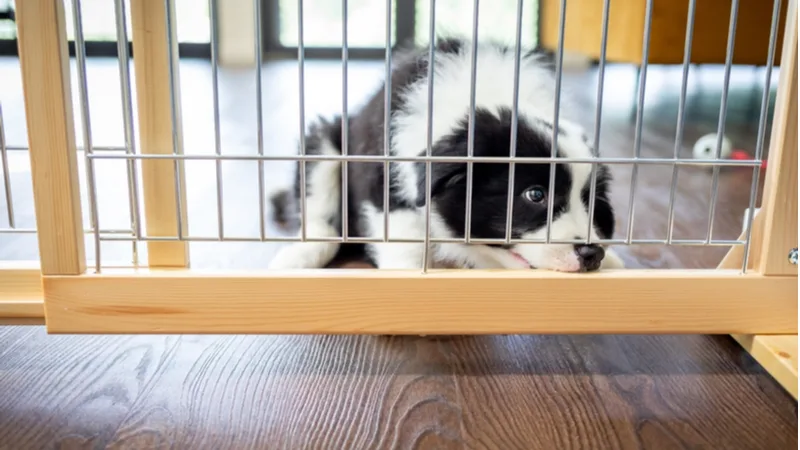Setting Up Dog Barriers at Home
Dog barriers are a great way to set boundaries for a puppy during the training process. Here are reasons to barrier up and how to choose the right one.

Many pet owners find themselves in a situation where they need to create canine barriers in their home. Perhaps they've just brought home a puppy and want to make sure they don't get into any trouble, or they have a new baby and are concerned about their safety.
In this article, we'll discuss when it's appropriate to put up barriers and how to do it effectively.
When Should You Put Up Dog Barriers?
There are a number of situations when it's a good idea to put up canine barriers in your home. Let's take a look at four of the most common:
Housetraining
One common scenario is when you have a new puppy and are still housetraining them. Puppies learn best when they have a clear boundary between what's allowed and what's not, so putting up some type of barrier can help reinforce the rules.
Introducing Pets
Another time you might want to consider putting up barriers is when you're introducing a new pet to an old one. For example, if you have a cat and are planning to introduce a new puppy, you should keep them apart until they've had time to adjust. Barriers can help each pet get used to the scent, sound, and sight of the other animal before first introductions take place.
Separating Young Children and Dogs
Canine barriers are also useful for keeping dogs away from babies and toddlers. It's always best to separate young children and dogs unless you can properly supervise them. Using a barrier is a great way to ensure that both the child and the dog remain safe.
Blocking Access to Unsafe Areas
Finally, canine barriers can be used to block off access to unsafe areas that you don't want your dog to enter. This might include the kitchen or bathroom, which may contain cleaners and other harmful substances that they could ingest. You may also want to block off the trash disposal area, so they don't eat anything that's been thrown away.
Why You Should Consider Using a Baby Gate
The humble baby gate is one of the best options for a dog barrier. Baby gates can be installed in doorways or across hallways so your dog can't get past them. These gates are usually made of wood or metal and have a latch on the top or side.
They're also readily available online and in stores and come in a wide variety of sizes, colors, and styles. Most baby gates are also relatively inexpensive, making them a budget-friendly choice. In addition, they're easy to install and can be moved from room to room as needed.
How to Choose the Right Baby Gate
There are several key things to keep in mind when choosing a dog baby gate. Here are some of the most important factors to consider:
The Size of the Gate
First, consider the size of the gate. If you have a large dog, make sure to choose a gate that's tall enough to keep them contained. This will also depend on whether or not they have a tendency to jump over things.
What It's Made From
Secondly, think about the type of material the gate is made from. If your dog is a chewer, it's a good idea to choose a metal gate over one made of wood or plastic. Metal gates are more durable and less likely to be damaged by chewing.
How It's Mounted
Finally, be sure to pay attention to how the gate is mounted. Some gates are hardware-mounted, which means they're attached directly to a wall or door frame. Others are pressure-mounted, which means they use tension to stay in place.
Hardware-mounted gates are a good permanent solution, but they can be difficult to install and are not easy to move around. Pressure-mounted gates, on the other hand, are an excellent option if you need a temporary barrier that can be moved from one place to another. They can be quickly and easily installed without any tools and removed when needed.
Dog Gates and Other Types of Canine Barriers
While baby gates make great canine barriers, there are other options as well. If you can't find a baby gate that suits your needs, a dog gate can be a good alternative.
Although dog gates are often more expensive than baby gates, they come in a wider variety of heights, styles, and materials. This means you're sure to find one that perfectly meets your needs. For example, if you have a very large dog, you can find a gate that's tall enough to keep them contained.
Another option is a dog pen. These can be used to create a designated area for your dog and are available in a wide range of different sizes and styles. However, they're better suited to smaller dogs since they are often not tall or sturdy enough to contain large breeds.
Finally, if you're good with your hands, why not make your own dog barrier? This gives you complete control over the design and size of the barrier, as well as the materials used. If you're looking for inspiration, this useful article includes 12 awesome DIY dog gate designs.
Safety First
No matter which type of canine barrier you choose, it's important to take the time to install it properly. This will ensure that your dog can't get out and is safe and secure in their designated area.
In addition, be sure to keep an eye on your dog when they're contained. Although barriers are a great way to keep them safe, they're not 100% effective and there's always a chance that your dog may find a way to escape. By following these tips, you can create a safe and secure environment for your four-legged friend.
Take some of the stress out of pet ownership with Accident & Illness Coverage from AKC Pet Insurance (underwritten by Independence American Insurance Company). Our pet insurance plans are designed to be there when you need them, allowing you to focus more on the health of your pet and less on costly veterinary bills.

Every Dog and Cat Deserves the Pet Insurance of Champions
Get prize-winning care for your pets.

Richard has shared his life with pets since childhood, and currently has a rescue cat and dog. He works with veterinarians and pet businesses to improve their content. To find out more, please visit his [website](https://richardrowlands.com/).
READ MORE ARTICLES

